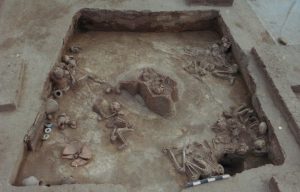
Researchers have provided geological evidence for China’s “Great Flood,” a disastrous event on the Yellow River from which the Xia dynasty is thought to have been born. The flood occurred in roughly 1920 BC, they say, which is several centuries later than traditionally thought — meaning the Xia dynasty, and its renowned Emperor Yu, likely had a later start than Chinese historians have thought, too. According to Chinese legend, Emperor Yu gained notoriety through his handling of the country’s Great Flood.
By dredging the destructive floodwaters, he tamed them, “earning him the divine mandate to establish the Xia dynasty … and marking the beginning of Chinese civilization,” Wu Qinglong and colleagues write.
Yu’s story was handed down for a millennium before entering the historical record, yet, geological evidence for the flood he mastered has always been lacking. Thus, “some scholars have argued that the story is either a historicized version of an older myth,” David Montgomery explains in a related Perspective, “or propaganda to justify the centralized power of imperial rule.”
Here, by reconstructing a sequence of events along the Yellow River — including a landslide that created a dam from which water built up and burst forth — Wu Qinglong and colleagues provide geological evidence for a catastrophic flood event that may be the basis of the Great Flood.
The researchers mapped and dated distinctive sediments that were deposited downstream of a Qinghai Province dam when the dam broke. In further work, they determined that the flood that broke the dam was of enormous proportions. Using radiocarbon dating techniques on samples that included human bone, they dated the flood to 1920 BC.
“The … flood shares the main characteristics of the Great Flood described in ancient texts,” the authors say. If their flood is indeed the event that came to be known as the Great Flood, researchers could propose a new start date for the Xia dynasty, at 1900 BC.
This date not only coincides with the major transition from the Neolithic to the Bronze Age in the Yellow River valley, possibly resolving a longstanding contradiction among Chinese historians about when Xia started in relation to this critical period in history, but it also coincide with the beginning of the Erlitou culture that dominated China in the early Bronze Age — supporting arguments that this culture is the archaeological remains of the Xia dynasty.
Taken together, these results reveal how the concurrence of these major natural and sociopolitical events may be an “illustration of a profound and complicated cultural response to an extreme natural disaster that connected many groups living along the Yellow River.
Reference:
Q. Wu, Z. Zhao, L. Liu, D. E. Granger, H. Wang, D. J. Cohen, X. Wu, M. Ye, O. Bar-Yosef, B. Lu, J. Zhang, P. Zhang, D. Yuan, W. Qi, L. Cai, S. Bai. Outburst flood at 1920 BCE supports historicity of Chinas Great Flood and the Xia dynasty. Science, 2016; 353 (6299): 579 DOI: 10.1126/science.aaf0842
Note: The above post is reprinted from materials provided by American Association for the Advancement of Science.










